 |
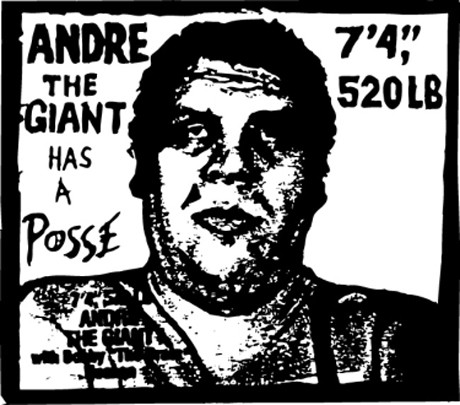 |
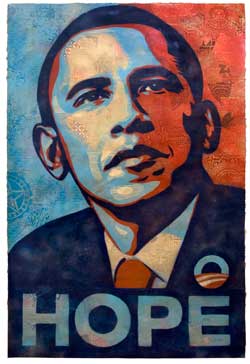 |
|
Examining Shepard Fairey's Street Art Through a Foucauldian Discourse Analysis |
 |
 |
 |
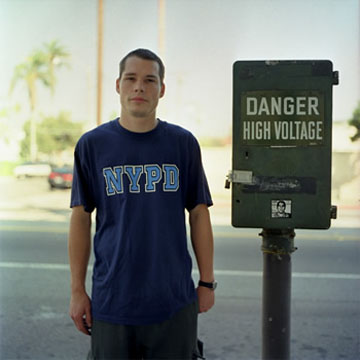 |
Shepard Fairey's art career has been defined by his use of street art tactics to disseminate his images. Starting with his "Andre the Giant has a Posse," sticker campaign and, most recently, his Obama Hope poster campaign, he has utilized the medium in a way that has gained him entrance to the art establishment. His pieces have gone from being displayed on buildings and other surfaces in the "street," to hanging in the National Portrait Gallery in the Smithsonian, as well as other museums. This analysis will focus mainly on three of Fairey's images: the "Andre the Giant has a Posse" sticker campaign, the OBEY sticker campaign (which is itself a derivative of "Andre") and his recent Obama Hope poster campaign. Central to this analysis will be Michel Foucault's conception of institutional apparatus and institutional technology (Rose 174). Particularly, this analysis will aim to answer the question: What effect, if any, do these different display environments have on the way in which his images are perceived? |
| In the case of Fairey's street art, the institution in which the art is displayed is contained within its name, the "street" or urban environment. For Michel Foucault, "...institutions work in two ways: through their apparatus and through their technologies" (Rose 174). Institutional apparatuses are, "the forms of power/knowledge that constitute the institutions: for example, architecture, regulations, scientific treatises, philosophical statements, laws, morals, and so on, and the discourse articulated through all these" (Rose 174). When his images utilize street art techniques, the surface upon which the image is displayed, its very presence in a "street" environment where anyone who walks by can view it, the government which views a piece of street art as an act of vandalism and public perception of the medium, are all institutional apparatuses that have the potential to influence the ways in which his images are perceived. The "practical techniques used to practise that power/knowledge," are called institutional technologies (Rose 175). In his street art, many institutional technologies are present, among them: the illegal manner that Fairey (and his legion of followers) posts his images, the surfaces considered most suited to the display of street art, the police who enforce governmental law that considers street art vandalism and the design of the different urban environments where his images are displayed. |
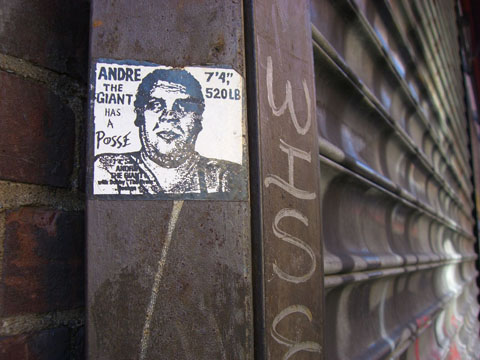 |
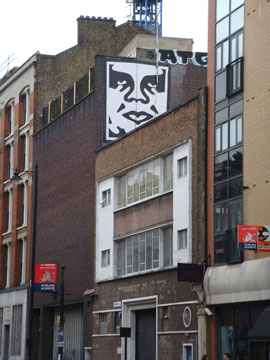 |
Fairey's first foray into street art was his "Andre the Giant has a Posse," sticker campaign in 1989 (McCormick 51). This modest campaign began as an inside joke with his skateboarding friends, but it evolved into a viral phenomenon with the advent of the OBEY campaign in 1995 as the stickers were placed in many different locations around the world through the help of "his own global volunteer posse" (Dooley 43). What was it about this image that allowed it to 'scratch' an international audience where they itched? Perhaps a better question to ask is the one Lynch asks when introducing his idea about the relation between environmental and social change, "If the individual affects and is affected by changes in his environment and if he affects and is affected by changes in his society, what then is the relation between environmental and social change?" (Lynch 215). Regarding Fairey's street art, the change that "the individual" incurs is one of environment e.g. Fairey placing a sticker on the back of a stop sign. Along with this, the mere presence of the image in the individual's environment affects him. But the question of whether or not this environmental change causes some sort of social change is not so easily answered. Fairey's OBEY campaign obviously struck a chord with people, but did it have an impact on society? |
|
Lynch goes on to talk about his idea of the "environment as
stabilizer" saying, "Any threatened institution, ascendant or
descendant, is likely to use environment as a stabilizer: to display its
power and its timeless endurance, to reinforce and perpetuate certain
ways of behaving" (Lynch 219). When considering street art as an
institution, and all the apparatuses and technologies it utilizes, the
change which Fairey affects upon his environment by posting his images
in public stabilizes the reactions and perceptions and shapes the
potential for social change. Thus, from this view, it seems that
Fairey's OBEY campaign necessarily had an impact on society. Also,
inside this social change a "particular human subject" is produced (Rose
172).
|
|
[Home]
[Foucauldian Discourse Analysis]
[The Social Lives of Images]
|